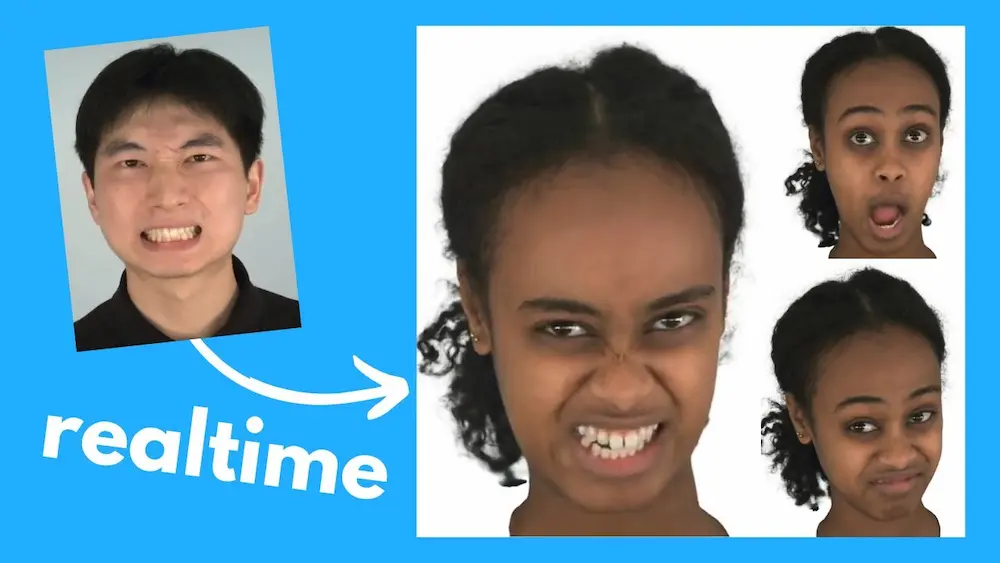Revolutionizing Digital Avatars: High Fidelity Unleashed

A new avatar generator has set the bar higher for digital likeness and fidelity. This model stands out as the most realistic and high-fidelity avatar generator seen to date. The technology behind it not only captures facial expressions with incredible precision but also maintains consistency in features like teeth and hair, areas where previous models have often failed.
Sample Demonstrations
To illustrate the capabilities of this new avatar generator, let’s look at some sample clips. In the first example, the real footage on the left is transformed into three different avatars. Despite the extreme expressions, the avatars look highly realistic. Another example shows a person’s face translated into two avatars, both maintaining impressive accuracy even with tricky facial movements.
Comparisons with older methods highlight the advancements made. The real footage on the far right shows the ground truth, followed by the new method, and then older, less accurate methods. The new method even handles teeth accurately, a common flaw in previous models. Microsoft’s Vasa 1 and Alibaba’s Emote Portrait Live have struggled with temporally consistent teeth shapes, an issue this model overcomes.
Technical Insights
The new model uses high-quality multi-view video as training data. Unlike Alibaba’s Emote Portrait Live or Microsoft’s Vasa 1, which require only a single image, this method needs multiple videos from various angles to create a realistic digital avatar. This approach, although challenging, results in higher fidelity avatars.
Core Technology
The model leverages Neuroparametric Head Models (MPHM), advanced neural network-based models that capture a wide range of facial shapes and expressions. These models use parameters to represent the head and its expressions, allowing for a diverse range of facial configurations. This is where technologies like DeepFace AI come into play, enhancing the model’s ability to capture and reproduce intricate facial details.
3D Gaussian Splatting
A key technique used is 3D Gaussian Splatting. Traditional 3D models use meshes, which are complex and computationally expensive. Gaussian Splatting, on the other hand, uses a collection of points (Gaussians) that describe the shape and texture of the object. This approach is quicker and requires fewer calculations, enhancing rendering efficiency.
Latent Features
Each Gaussian point in the avatar has latent features, which contain hidden information about how the point should move or change with different expressions. This results in more accurate and realistic facial movements. The final rendering is achieved through 3D Gaussian Splatting, which efficiently displays the avatar. DeepFace AI technologies also contribute to the accuracy of these latent features, making the avatars even more lifelike.
Experimental Results
The model has been tested through self-reenactment and cross-reenactment experiments. Self-reenactment uses a person’s face to animate their own avatar, while cross-reenactment animates an avatar of a different person. Both methods show that the new model preserves identity and expression better than previous models.
Addressing Artifacts
An ablation study revealed that while per-Gaussian features improve detail and sharpness, they can also introduce errors under extreme expressions. To mitigate this, smoothing algorithms and a ScreenSpace CNN are used to remove distortions, especially in the teeth. DeepFace AI can also help in this area by providing advanced algorithms for artifact removal.
Performance
The model can render images at 31 frames per second for 550 by 802 pixels and 18 frames per second at 1100 by 1604 on an NVIDIA RTX 3080. Training an avatar takes roughly 30 hours, indicating the substantial computational resources required.
Future Applications
While the technology is compelling, access is currently limited. The GitHub page for the code is not yet available. However, the rapid advancements suggest that realistic digital avatars could soon be used in various applications, such as online meetings, augmented reality, and even the metaverse. Technologies like DeepFace AI will likely play a significant role in these applications, enhancing the realism and usability of digital avatars.
The potential for both beneficial uses and misuse, such as scams, is significant. As the technology evolves, it will be crucial to consider its implications and manage its deployment responsibly.
Conclusion
The advancements in avatar generation technology are truly groundbreaking, offering unprecedented realism and fidelity. As we look towards the future, the potential applications of this technology are vast and varied, promising to revolutionize fields such as virtual meetings, entertainment, and augmented reality. However, as with any powerful technology, it is essential to use it responsibly to maximize its benefits while minimizing potential risks.
For those interested in exploring similar advancements in AI-driven face technology, check out AiFaceSwap. With AiFaceSwap, you can create viral-worthy, entertaining video face swaps instantly using our powerful AI technology. Visit AiFaceSwap to learn more and start creating your own realistic face swaps today!
